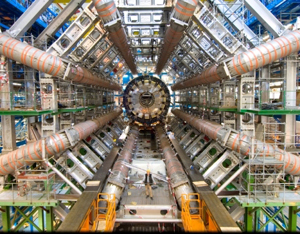Lancaster physicists analyse fresh ‘big bang’ data

Lancaster scientists are eagerly awaiting the new data after the Large Hadron Collider smashed its own record for the highest energy particle collider.
On Tuesday, 30th March the Large Hadron Collider in Geneva, Switzerland began colliding particles at an energy three and a half times higher than the next most powerful facility, at Fermilab in Chicago.
Lancaster physicists on the largest of the experiments, ATLAS, will be searching through the traces of the particles produced in the collisions for traces of new physics.
On the day of the collision Professor Roger Jones, head of the Lancaster ATLAS group, helped present live streaming of the first collisions and explained the early events at a media event in London.
He was also involved with a conference in London where some of the data already collected before Christmas was presented, and the opening of a major computing centre at the Rutherford Appleton Laboratory (RAL) in Oxfordshire.
At RAL, a major computing centre was formally opened which will help process the ATLAS data in tandem with large facilities such as the High End Computer Centre at Lancaster.
Professor Jones is in charge of the computing for ATLAS in the UK.
He said: “We have built a huge world-wide system of computers to store and analyse the ATLAS data, and it is working incredibly well so far – but now the real work begins!”
Dr James Catmore is already based in Geneva, and jointly heads the team looking at the physics of some of the heaviest particles seen so far, so-called ‘beauty’ particles.
They will be looking at the data to ensure that both nature and the ATLAS detector are behaving as expected, so that any indications of new phenomena that may be observed can be understood with confidence.
He said: “This is a very exciting time to be working in physics; lots of young physicists and postgraduate students will be combing the data with computer programmes, and also by looking at interesting events on graphical displays, in a friendly competition to seek what surprises are in store.”
The Lancaster group is working on many major questions; the origin of mass and the search for the so-called Higgs particle; the reason for the absence of antimatter in our everyday world; and the search for candidates to explain the mysterious dark matter that makes up much of the universe.
Particle Physics and Accelerator Science are vital tools for attempting to understand what the universe is made up of, by breaking it down into its tiniest constituents. To do this scientists recreate the moments after the big bang by using a particle accelerator – a high-energy machine that speeds particles up using high-frequency electric fields. As they approach the speed of light, they collide with one another breaking down into smaller units – the fundamental building blocks which make up the universe.